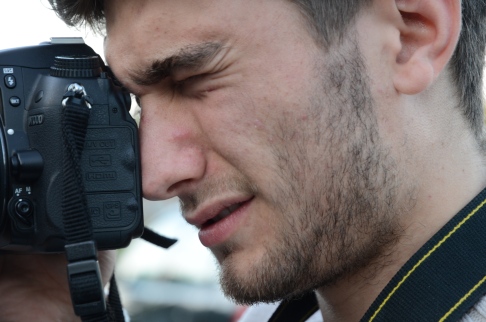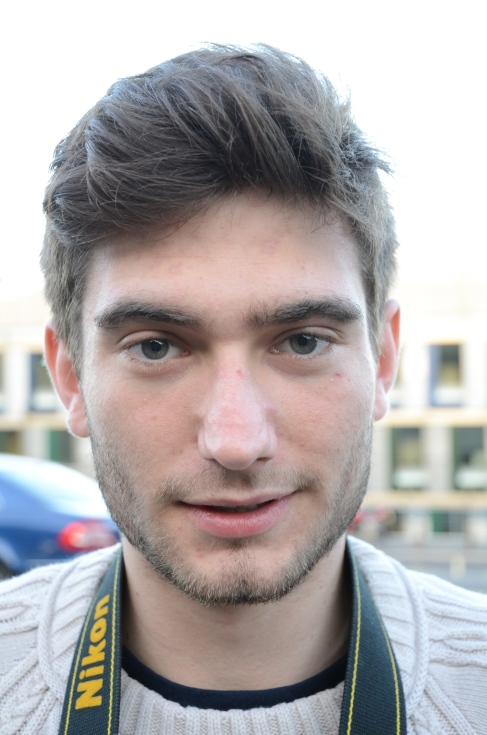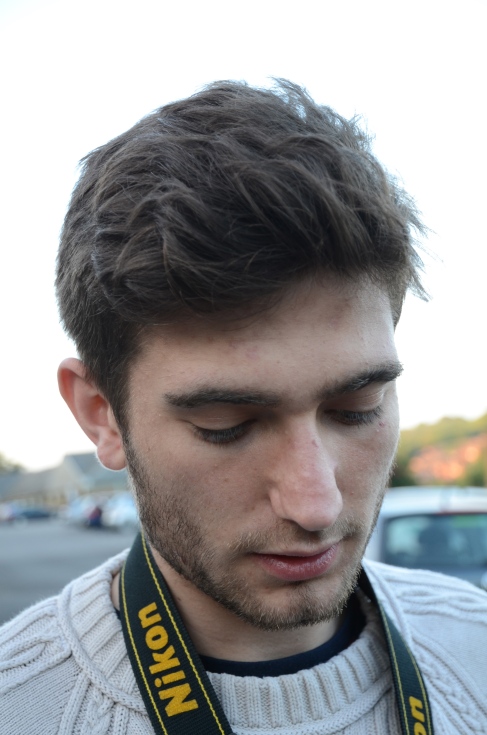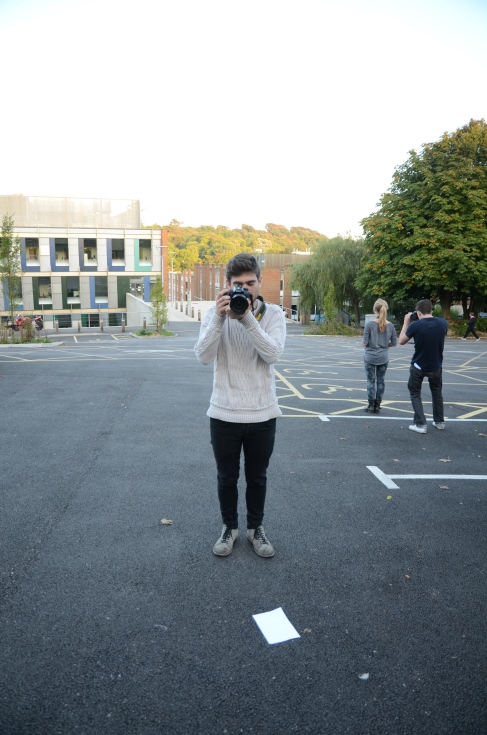- Shoot around the the subject
- Find the alphabet
- Mini project
- The Letter U
- The Letter V
- The Letter I
- The Letter T
- The Letter O
- Shoot around the subject. I was drawn to photographing the doors around the Jubilee Hall which have really good lighting and bright vibrant colors.
- The Letter X
- Mini Project. In these series of photos I’ve used the highest ISO and I really enjoy the grainy effect it produces. I feel it accentuates the dark, slightly depressive mood of the abandoned building.
- I found a small area of the university that was no longer in use and very much isolated from the rest of the campus. I like the composition of this photo as there’s a contrast between the abandoned building and the bright life outside, the phone seeming to be the connection between the two. However, I think it seems clear by judging from the other photos this phone is clearly not in use.
Monthly Archives: October 2013
21.10.13
Posted in Uncategorized
Ways Of Seeing – Berger (Chptr 1)
“Seeing comes before words. The child looks and recognizes before it can speak.”
What we see challenges what we know. Our knowledge doesn’t always fit the site. This is demonstrated in the surrealist artist’s, Magritte, painting ‘The Key of Dreams.” Our outlook and judgement on things is subjective to general perception and accepted beliefs e.g medieval era fire meant hell. Do we view things metaphorically or literally?
Photographers perspective is reflective in their photos. Photos can demonstrate how people/events were perceived at a certain time (how did X see Y?) There’s been in increase in consciousness of individuality and self awareness. It began during the Renaissance, where it’s been argued that images are more precise and richer than depicting historical events than literature.
Art from the past is mystified as it was a privilege for the upper class. The paintings try to justify the role of ruling classes but now, in modern age, the justification no longer makes sense so art from the pasts historical value is mystified.
Frans Hals
Did a series of paintings of governors and governesses of Alms House for old paupers in Dutch 17th century of Haarlem. The paintings were officially commissioned. Hals was very poor and actually received charity from those he was painting, and there is said to be no bitter tones in his painting.
Argued that the painter ‘seduces’ us into allocating subjects in his paintings with personality traits and habits – and we accept this as long as it corresponds to our own observations of peoples, gestures, faces, institutions.
The camera destroyed the idea that images (art) was timeless. Paintings/drawings implied the artist was the unique center of the world at that time, with a unique perspective. The camera demonstrated there was no center and changed the way that man saw he world. This was demonstrated within paintings. Art became far more abstract as the ultimate reality had been perfected.
Paintings were previously seen as an integral part of society as they couldn’t be duplicated and shaped their surroundings. But photos destroyed their uniqueness and their meanings were fragmented with duplication, and each duplication had a different meaning. A replica of a painting embraces and takes on the context of its surroundings and lends it’s meaning to other peoples meanings, which are always different. Original productions are no longer originals but originals of reproductions.
This is where mystification enters again, the painting is no longer about what it uniquely says, but what it uniquely is, how it’s defined and evaluated in our present culture. It’s is valued at it’s market worth, rarity and bogus religiosity. Rooms at museums are turned into shrines for singular paintings. We are made to feel it is authentic, therefore it’s beautiful.
What does reproduction do to a painting?
It can isolate a detail from a painting, and that detail is transformed and taken out of context.
When filmed becomes material for film makers argument as they manipulate what we see and when, whilst constructing an argument around it so our perception is biased and we don’t evaluate the whole piece of art independently.
When reproduced it is often surrounded by words, which has a similar effect as the above. The image is changed by external interaction.
Is often compared to something else so becomes a reference point/reference, and looses its individuality.
Has art from the past lost it’s charm?
By viewing the original you are still closing the gap between when it was produced to the present moment you are looking at it (i.e analyzing the brush strokes, technique…)
Who does art belong to? Cultural hierarchy of relic specialists or those who can apply it to their own lives?
Modern reproduction has destroyed the authority of art. Images have become valueless, unsubstantial, free.
There is a new language in art, who uses it? Issuers of copyright, publishers, policy makers for art galleries etc…
A class cut off from its past is less free to choose/act as a class/individual then one that’s


 been able to situate itself in history. This is why art is now a political issue.
been able to situate itself in history. This is why art is now a political issue.
- art of the past
- duplication
- significance of perspective
- class
- unique
- reproduction
- mystification
- market value
Posted in Uncategorized
Task 4: Interacting With The Public
In this task we were asked to go out into Brighton and produce a series of shots of a shop keeper with these outlines
1. Interacting with the subjects i.e moving their head, shoulders etc 2. A wider shot of them in the workplace or outside posed 3. A shot of them working 4. A shot of them interacting i.e serving a customer 5. A contextual shot without them 6. A close-up
- Contextual shot without shop keeper. In the studio there were lots of beautiful stuffed birds decorated around. I’ve tried to connect this particular bird to the shot by capturing it’s eye. I also like how prominent contrast of the light from the outside against the shadows from the Gothic, dark tattoo parlor.
- Close up. Again, I was very drawn to the taxidermist vibe of this setting. There was a kind of unconventional maternal feel about Fi, the woman who I photographed which I tried to capture with her touching the bird in a tender, motherly way. The darkness and shadows emphasis on this mood I attempted to translate.
- Portrait. I used a high ISO setting and slow shutter speed to get as much light in the dark parlor as I could. I wanted to emphasize on her ivory skin tone and ‘unconventional’ beauty. However, I think y ISO setting was too high and I lost some definition. If was to do this again I would’ve brought a tripod and used a slower shutter speed.
- A close up. This I think encompasses the general mood of the parlor – beautiful and dark.
- A wider shot of them in the workplace. As you can see, the shop is filled with such beautiful things, antique chairs, long draping curtains, wooden floor, silk, sparkles. The variety of colors and textures are stunning and placing Fi in the middle, holding Mr Peaches, produces a feast for the eyes and captures the vibe of this setting.
- I shot this photo in portrait mode as I wanted to give a little more depth to it and elongate the room.
- A shot of them working. Tattoos are seen as quite a taboo to some so I wanted to emphasize on this view point by placing Fi in the shadows of her work place, as the outside worlds light shines in almost aggressively, as she ‘hides’ away.
Posted in Uncategorized
How Do We Read A Photograph?
The Photograph – Graham Clarke – Chapter 2. 1997.
Photographic discourse – language of reading a photo
Diane Arbus – her work has ideological context
Photo’s have ‘photographic messages’ – codes, values, beliefs. Representing the world at a time.
Must read photos as a product from the PHOTOGRAPHER. They are never passive.
Most 19th century photos seen as literal records
Color schemes and spatial awareness are used to create another level/message to the photo
Pay attention to the photographs title as it has a lot of significence i.e ‘identical twins’
Photo is as much as a reflection on the photographer as it is its subject
Denotative- literal significance of objects in the photo
Connotative – what they are implying and reflecting on a much grander scale
STUDIUM
PUNCTUM
Posted in Uncategorized
John Ingledew – Photography (Chapter 1&4)
A brief summary of chapter 1 and 4.
Chapter One.
Black and white photos – Silver darkens when exposed to light
Colour – three different coats of silver/layered – each layer to record one of the primary colours
Digital
– one block is a solid colour (like painting by numbers)
HISTORY – 1300 magnifying glasses were common. Venice – shaped them into small discs of glass like shapes of lentil beans – first reading glasses – ‘lentils of glass’ – lenses
Film Cameras
35mm single lens reflex camera (SLR)
- light tight cassettes 24/36 exp
- winding resets shutter
- interchangable lenses
- built in light meters
- light and quick – pictures can be grainy when blown up
Medium format single lens reflex camera
- 120 size roll film on plastic spool
- film taped to paper allow roll to be loaded in the light before being wound
- 6x6cm pictures (4x more than 35mm pic)
- lenses interchangable
- film held in detachable back
- v. good quality negative slides
5×4 view camera
- used mainly on tripod
- field/plate camera
- 5×4 inch film
- can see image exactly through lens
- intense quality to photos
Posted in Uncategorized
Session 3: Portraits
07.10.13
What I have done in each of these photos is tried to draw attention to certain things and create a mood in each one.
The close up of the wrinkles in Henry’s eye in the first photo display tension and concentration, giving a sense of life and action to it.
In the second photo Henry is facing absolutely center to the camera, which makes the on-looker examine and scrutinize the layout of his face. We evaluate the shapes of his eyes, lips, jaw line, stubble and expression that is hidden away in the very subtle smile. This photo I think raises the most questions about its context.
Henry is disengaged from the third photo as we do not see his eyes nor the object he is focusing on. However there is a sense of tension in his brow and perhaps a shot of solemness in his general expression. Its a quick shot that has captured a passing but to me, significant moment.
The last photo is a full, centered body shot parallel to the photographer, me. Rather than focusing on Henry, to an onlooker, it should make them think that the photo is about the person taking the picture, not the person within it.
Posted in Uncategorized
August Sander.
Notes from presentation 07.10.13
- 1876-1964
- German portrait photography
- Witnessed transition of agriculture to a modern state
- Famous book “People of the 20th century” displaying society in their hierarchy of occupations
- His work was seized and destroyed by Nazi’s as they did not portray what they deemed as ‘typical’ German’s.
- His brother was imprisoned for not conforming to Nazi beliefs and after 10 years died in jail.
- Documentary photographer
- Jacob Ris, Guy Tillim.
- I particularly like this photo as it challenges the Nazi’s ideologies of the Aryan race. Her facial structure is somewhat crooked, and her large features are intriguing. I can see a lot of pain in her eyes, and the shadows are cast upon her face in such a way they look almost like bruises. The photo is beautiful in its uniqueness but also almost uncomfortably intimate, due to its close range and high definition.
Posted in Uncategorized
Previous Works 1
- Low depth of field
- High depth of field
- Slow shutter speed
- Fast shutter speed
- High depth of field, Valencia, Spain, 2012
- Slow shutter speed, The Yasuni National Park, Ecuador, 2012
- Low depth of field, Valencia, Spain 2012
- Fast shutter speed, Penzance, UK, 2013
- Fast shutter speed, high depth of field, Penzance, UK, 2013
- High depth of field, Yasuni National Park, Ecaudor, 2012
- Low depth of field, Yasuni National Park, Ecuador, 2012
- High depth of field, The Andaman Islands, India, 2013
- High depth of field, The Andaman Islands, India, 2013
- Low depth of field, Yasuni National Park, Ecuador 2012
- Slow shutter speed, Bameno, Ecuador 2012
- Low depth of field, fast shutter speed, Madrid, Spain 2013
- Low Depth of Field, Poisonous Arrows, Bameno, Ecuador 2012
This photo was taken by Hiroshi Sugimoto, it’s title being Cabet Street Cinema, Massachusetts, 1978. It was shot with an hour and a half long exposure. A film was being played during this time and there were people coming and going, but you can see neither. I think knowing this information after your initial response to seeing the photo demonstrates the importance of context and how it can add another level to reading and enjoying a photo.
Posted in Uncategorized

















































Recent Comments